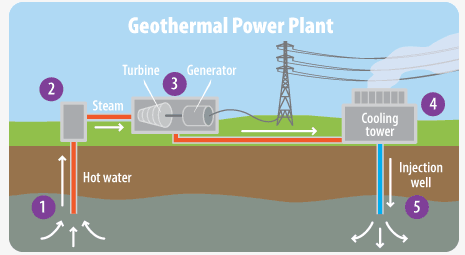Geothermal Power
While geothermal may be one of the less talked about sources of renewable energy, geothermal is already a big part of the California renewable energy scene (22 percent of renewable power) and has the potential to be even bigger.
While geothermal isn’t possible in many areas due to the geographic requirements, there is abundant geothermal resource in California near the Salton Sea, a region near and dear to our hearts at Audubon California. An estimated 1500-2000 megawatts of geothermal capacity is untapped in the Imperial Valley alone. For scale, the entire state of California demands about 30,000 megawatts.
Salton Sea and other similar areas are ideal locations because geothermal energy is produced by tapping into the earth’s heat where the molten rock is closest to the surface. The heat is then used to turn water into steam, which spins a turbine to generate the electricity. As shown in the diagram below, the water can then be cooled.

One reason geothermal could be such a vital part of the renewable energy portfolio is that it provides stable, baseline power. Although we can keep adding wind and solar energy, this energy is not constant throughout the day; geothermal can be produced 24/7. This means that geothermal can viably replace natural gas and coal—the traditional baseline power sources.
The greatest benefit of geothermal energy where Audubon California is concerned, however, may be that it has very few wildlife siting concerns. Because much of the action occurs below ground, the land footprint is extremely small. Additionally, since geothermal is inherently in very hot, less inhabitable locations, geothermal power plants are unlikely to disrupt habitat. In fact, geothermal can be placed on uneven desert land where solar would be much more challenging to install.
Some extra co-benefits? Geothermal plants employ more people to run the facility continually, not just temporary installation and maintenance jobs. Further, geothermal plants hold the potential to be paired with mineral extraction processes for materials like lithium to be used in high-capacity batteries. It’s an ecological, economical win.
Audubon California supports renewable energy when it is sited properly to avoid, minimize or mitigate effectively for impacts on birds, other wildlife and habitat.
How you can help, right now
Get Audubon CA in Your Inbox
Our newsletter is fun way to get our latest stories and important conservation updates from across the state.
Donate to Audubon
Help secure the future for birds at risk from climate change, habitat loss and other threats. Your support will power our science, education, advocacy and on-the-ground conservation efforts.
HOTSPOT: Flyover of California's Birds and Biodiversity
California is a global biodiversity hotspots, with one of the greatest concentrations of living species on Earth.



